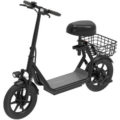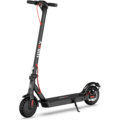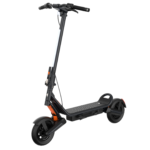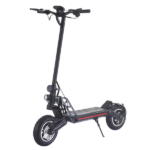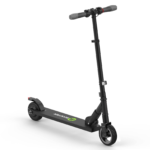- Home
- Scooters
- Electric Scooters
- Hiboy KS4 Pro
Hiboy KS4 Pro
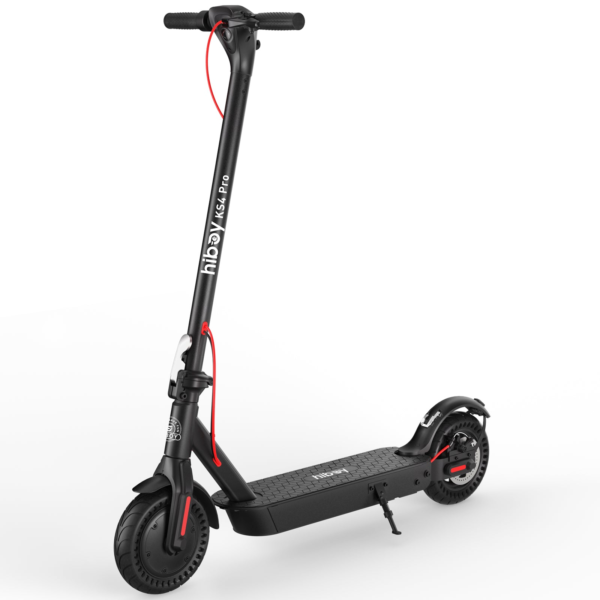


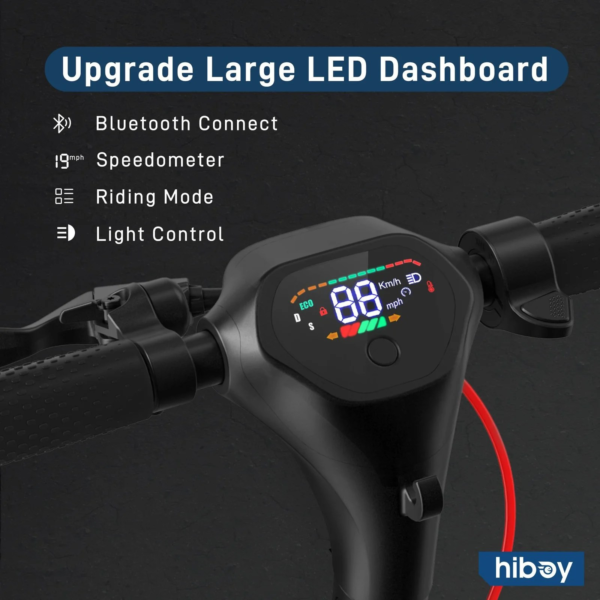
- Battery Range: 25 mi (35–40 km)
- Top Speed: 19 mph (30.6 km/h)
- Motor Power: 500 W nominal
- Weight Capacity: 220 lb (100 kg)
- Charging Time: ~5–7 h charge
- Scooter Weight: 40.6 lb (18.4 kg)
PROS
- Rear-wheel drive, friendly throttle
- Maintenance-free 10″ honeycomb tires
- Front electronic + rear disc brakes
- Bright lights + clear LED dashboard
- Quick fold; app lock & cruise control
- IPX4 splash resistance
CONS
- Solid tires ride firm on rough brick
- No full suspension (rear spring only)
- Range dips in cold/headwinds
- Not intended for heavy rain use

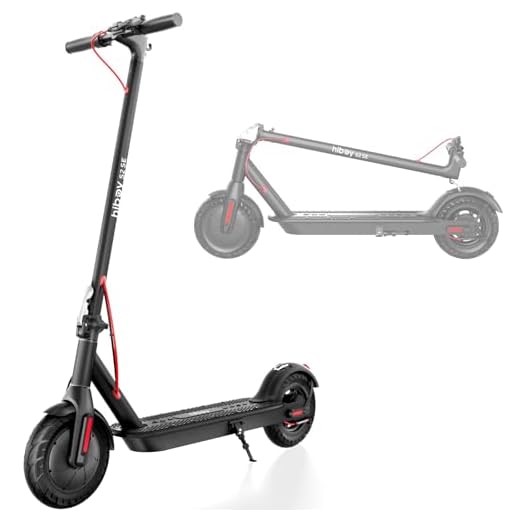
Overview: Hiboy KS4 Pro for Everyday Commuting
Quick take: daily calm, not drama
The Hiboy KS4 Pro is built for real streets and real riders. It favors steady speed, predictable control, and low maintenance. Moreover, it folds compactly for trains, office corners, and small apartments. A 500 W rear-hub motor (750 W peak) pairs with a 36 V, 11.6 Ah battery and 10-inch honeycomb tires. Consequently, it reaches a regulated 19 mph (about 30.6 km/h) and delivers practical range for typical city loops. Additionally, IPX4 splash resistance, a rear spring shock, front electronic + rear disc brakes, and bright lighting support safe, confident commuting.
In short, the KS4 Pro is a sensible tool. It starts smoothly, tracks straight, and stops with confidence. Furthermore, it avoids flats and fussy upkeep, so ownership stays simple month after month.
Who will enjoy it most
This scooter suits commuters, students, and new riders who want calm control. Because the deck sits low and the steering feels neutral, lane shifts feel natural. Likewise, the friendly throttle curve helps riders place speed with precision. If your route is mostly paved and fairly flat, the KS4 Pro fits. However, riders who need 25+ mph or frequent long climbs should consider higher-power classes.
Power delivery: smooth, steady, confidence-building
Press the thumb throttle and the rear wheel pulls cleanly. As weight shifts rearward, traction increases, which reduces slip on paint or dust. Moreover, the motor rolls on in a progressive arc, not a spike. Therefore, riders feel in control from the very first block. In bike lanes, holding pace is easy. Additionally, the scooter settles into cruise without nervous twitch or surge.
Handling and chassis feel
A long deck and low ride height keep the chassis planted. As a result, shoulder checks feel safe, and mid-corner corrections feel precise. The steering is neutral rather than quick, which helps new riders most. Furthermore, the rear spring softens sharp edges, so hands relax and eyes stay up. On brick or choppy asphalt, a light knee bend smooths the ride.
Real-world range you can trust
Range depends on speed, temperature, terrain, and rider mass. On flat bike lanes at 12–16 mph, careful riders often see mid-20s miles per charge. However, headwinds, hills, winter cold, heavier loads, and full-speed cruising reduce that figure. Even so, you can stretch distance with smoother inputs and earlier coasting. For example, roll off before red lights and time greens to maintain momentum. Consequently, you save energy without sacrificing arrival time.
Charging strategy for longer battery life
A full charge typically takes 5–7 hours. Therefore, midday top-ups work well when your loop pushes the limit. Additionally, avoid daily deep discharges. For storage beyond a week, park the battery around 40–60%. This simple habit preserves cell health through the cold season. In winter, charge indoors at room temperature. Thus, the pack warms evenly and delivers steadier power the next morning.
Braking: electronic assist plus mechanical bite
The KS4 Pro uses a front electronic brake with regen and a rear mechanical disc. Together, they provide balanced control. Light lever pressure yields smooth trimming. Meanwhile, stronger pulls add familiar disc bite for quick stops. In drizzle, lengthen braking distance and ramp the lever rather than grabbing it. Consequently, grip stays predictable, and the scooter remains composed.
Tires, suspension, and road feel
The 10-inch honeycomb tires shrug off nails and glass that compromise tubes. Therefore, daily reliability improves. However, solid cores ride firmer than high-volume pneumatic tires. To compensate, Hiboy adds a small rear spring. Additionally, rider posture matters. With soft knees and light ankles, the deck feels calmer, and steering inputs remain precise. On rough sections, unweight over seams. As a result, impacts soften, and fatigue drops.
Lighting and visibility after dark
A bright headlamp lights near-field obstacles. The taillight brightens under braking, which signals intent to traffic behind you. Additionally, side reflectors boost passive visibility when headlights sweep across you. For very dark shortcuts, add a compact bar-mounted light and a backpack flasher. Consequently, you become visible from more angles, which improves safety in mixed traffic.
Portability and storage
The fold takes seconds and locks with a positive snap. Hiboy lists weight around 40.6 lb (18.4 kg); some materials show ~38.5 lb (17.5 kg). Either way, short stair carries are manageable. Moreover, the folded footprint (about 45.3 × 18.9 × 20.7 in) fits beside a desk or under a café table. In tight halls, turn the bar inward, and the deck sits flush to the wall. Thus, you move through crowds without bumping shoulders.
Fit, stance, and ergonomic comfort
Stand with your front foot angled and your rear foot across the deck. Additionally, keep knees slightly bent and elbows soft. This stance lowers your center of gravity and turns your legs into natural suspension. On longer rides, swap lead feet every few minutes. Consequently, hips and knees share load, which reduces hotspots and tingles. On rough bricks, unweight over seams and land softly.
Dashboard, app features, and cruise control
The LED display shows speed, battery, and mode at a glance. The Hiboy app adds an electronic lock, cruise control, and ride stats. Additionally, firmware updates may refine throttle feel or regen strength over time. Use cruise control only on clear, straight paths. Consequently, your thumb rests while your attention remains high. A solid, mechanical phone mount helps with navigation; elastic bands can slip on cobbles.
Hills, heat, and cold
Hiboy rates the KS4 Pro for up to about a 15° grade. Short ramps feel fine with a rolling start. However, sustained climbs will slow the scooter, which is normal for this power class. Instead of sprint-and-coast, hold a steady 13–16 mph when possible. Consequently, you avoid heat spikes and preserve battery.
Cold affects range. Below ~10 °C, expect a temporary dip. Therefore, plan conservative routes and charge at work if needed. In summer, park in shade. Excess heat ages cells faster than miles do.
Riding in rain
IPX4 splash resistance helps during brief showers. Nevertheless, constant rain riding increases wear on bearings and switches. In the wet, lower speed and increase following distance. Additionally, avoid metal grates, smooth stone, and paint at sharp angles. Brake earlier and more progressively. Consequently, grip stays predictable, and you stay upright.
Maintenance: five minutes that pay off
A short monthly checklist prevents creaks and drift:
- Check the folding latch for play.
- Verify brake cable tension and pad condition.
- Inspect fasteners on bar, stem, axle, and caliper.
- Spin wheels to check for rub and debris.
- Wipe hinges and levers after wet rides.
Additionally, keep the charge port clean and the charger off dusty floors. Consequently, the fold feels tight, the brakes stay crisp, and the scooter ages well.
Security and storage habits
Use the app lock for quick coffee stops. For longer errands, add a compact U-lock or quality folding lock. Secure the frame to a fixed object where allowed. Additionally, choose visible racks near foot traffic. At home, store indoors, away from heat sources. Record the serial number and photograph your scooter. Consequently, recovery and reporting are easier if needed.
Accessories that add value
A few small items improve daily comfort:
- A high-output compact headlight for dark lanes.
- A bright, friendly-tone bell for shared paths.
- Thin full-finger gloves for shoulder seasons.
- A small stem bag for a lock and charger.
- A rigid phone mount with a mechanical clamp.
Furthermore, keep the cockpit uncluttered. Thus, your hands wrap the grips fully, which improves control during surprises.
Reliability: what honeycomb tires change
Honeycomb tires resist punctures that ruin mornings. Consequently, your commute starts on time more often. The trade-off is feel. Solid cores transmit more texture than air. However, the low deck and rear spring help, and rider posture helps even more. With softer knees and relaxed wrists, the ride feels composed. Likewise, choosing smoother lines over cobbles reduces chatter.
KS4 vs KS4 Pro: what the “Pro” adds
The Pro steps up to a 36 V, 11.6 Ah pack and 10-inch tires. Additionally, it carries higher nominal and peak power. Therefore, you charge less often and ride more calmly over mixed surfaces. Hill pace also improves slightly. By contrast, the standard KS4 weighs less and suits riders who carry upstairs often. Choose based on route, storage, and distance rather than brochure headlines.
Importantly, review the specifications once, then match them to your routine. As a result, you pick a scooter you will actually ride.
Common commuting scenarios
City center with bike lanes: Hold 12–16 mph and flow smoothly. Moreover, use cruise control only on straight segments.
Suburban connectors at dusk: Add a secondary headlight and a backpack flasher. Consequently, drivers judge your speed earlier.
Multi-modal trips: Fold quickly on platforms and hold the stem near the hinge. Thus, weight balances better in tight spaces.
Campus and errands: The app lock, a loud bell, and a light cable lock speed short stops. Additionally, a stem bag keeps pockets clear.
Safety gear and polite riding
Wear a certified helmet with a snug fit. Gloves protect palms and improve grip. In low light, add a reflective sash or ankle bands. Additionally, signal intentions early with clear body language and gentle bell taps. Yield to pedestrians on shared paths and pass with space. Consequently, everyone feels safer, and local attitudes toward scooters improve.
“Specifications” in context: what actually matters
Wattage, battery size, and tire type help you compare models. However, daily satisfaction comes from control feel, braking confidence, and storage ease. Therefore, match the scooter to four realities: distance, weather, storage, and charging. If those align, you will ride often. If one fails, you will ride less. The KS4 Pro hits a sweet spot for many urban routes.
Buying checklist before you commit
- Measure your storage space; confirm the folded footprint fits.
- Time your route at a relaxed pace; add a 20% range buffer.
- Inspect your steepest hill; plan a steady climb, not sprints.
- Test lever reach and bar width if possible.
- Budget for a bright headlight, a decent lock, and gloves.
Additionally, consider where you will charge and where you will park. Consequently, the first week feels easy rather than stressful.
Seasonal care, year-round confidence
Spring: Grit hides in hinges. Therefore, wipe and re-lube latch points lightly.
Summer: Heat stresses cells. Consequently, avoid hot car trunks and charge in shade.
Autumn: Wet leaves cut grip. Moreover, brake earlier and avoid sharp lean on paint.
Winter: Cold reduces range. Therefore, plan shorter loops and charge indoors.
After wet rides, wipe the deck, stem, and hinge. Additionally, avoid spraying the rotor or pads with lubricant. Thus, braking stays strong and squeal-free.
Troubleshooting early, saving money later
Hear a new creak? Check the stem clamp and deck bolts first. Notice a faint rub? Inspect rotor alignment and pad wear. See reduced range? Verify speed, temperature, and tire condition. Additionally, confirm the pack reaches full charge. Consequently, you catch small issues before they become big repairs.
Riding manners in mixed traffic
Hold a straight line and signal early. At bus stops, slow down and give space. Additionally, angle your headlight slightly down at night to avoid dazzling. When passing, do it with margin and with a friendly bell tap. Consequently, conflicts drop and trust rises.
Comfort tuning without mods
Handlebar roll and lever angle shape wrist comfort. Therefore, rotate the brake lever so your wrist stays neutral. Place the display where you can glance without turning your head. Additionally, keep cable loops smooth to prevent snags. Grip with relaxed fingers rather than a hard fist. Consequently, numbness fades and control improves on bumps.
Final verdict: small wins, big impact
The Hiboy KS4 Pro is not about extremes. Instead, it stacks small advantages that matter every day. You get a friendly throttle, a planted chassis, low-maintenance tires, reliable brakes, and a compact fold. Additionally, the 36 V, 11.6 Ah battery covers common urban loops with reserve. Maintain it lightly and ride it smoothly. Consequently, it will deliver months of calm, predictable commuting.
Summary highlights
- Motor & battery: 500 W rear hub (750 W peak), 36 V, 11.6 Ah.
- Speed & range: About 19 mph top speed; practical mid-20s miles with careful pacing.
- Brakes: Front electronic with regen + rear mechanical disc for balanced control.
- Tires & comfort: 10-inch honeycomb tires; rear spring; firm but reliable ride.
- Weather: IPX4 splash resistance; brief showers okay with caution.
- Portability: Quick fold; ~40 lb class; compact footprint for desks and trains.
- Features: LED dashboard, app lock, cruise control, and potential firmware refinements.
- Use case: Commuters and students seeking predictable thrust and simple ownership.
Review the specifications once, then return to your route, storage, weather, and charging plan. Consequently, you choose a scooter you will ride often—and enjoy.
Specifications
General
| Model The Model specifies the exact version or name of the scooter. It helps identify its unique design, features, and specifications within the manufacturer’s product line. Knowing the model makes it easier to compare options, find compatible accessories, or look up support information. | KS4 Pro |
| Brand The Brand identifies the manufacturer or company that designs and produces the scooter. A trusted brand is a sign of quality, reliability, and good customer support. Well-known brands often have higher standards for safety, performance, and after-sales service, giving you more confidence in your purchase. | Hiboy |
| Release Date The Release Date indicates when the scooter model was officially launched on the market. This helps you know how current the design, technology, and features are. A newer release date often means updated components, improved performance, and the latest safety or smart features. | 17 November 2025 |
| Recommended Age Recommended Age indicates the minimum age range that the scooter is designed for, based on safety, size, and ease of use. Following the recommended age helps ensure that riders can handle the scooter’s speed, weight, and controls comfortably and safely. Always check local laws and use protective gear, especially for younger riders. | Recommended 16+ |
Performance & Power
| Motor Power (Wattage) What it means: The motor power, measured in watts (W), shows how strong the scooter’s electric motor is. Why it matters: Higher wattage usually means better acceleration, more torque, and improved performance on hills or rough terrain. For example, a 250W motor is good for flat city roads and light riders, while a 500W or 1000W motor provides more power for faster speeds or climbing steep inclines. | 500 W nominal (750 W peak) |
| Top Speed The Top Speed indicates the maximum speed that the scooter can reach under optimal conditions. It’s usually measured on level ground with a fully charged battery and an average rider weight. A higher top speed allows you to travel longer distances faster, but always ensure you ride within legal speed limits and your personal comfort zone for safety. | 19 mph (30.6 km/h) |
| Battery Capacity Battery Capacity refers to the total amount of energy the scooter’s battery can store, usually measured in ampere-hours (Ah) or watt-hours (Wh). A higher battery capacity means you can ride longer distances on a single charge, reducing the need for frequent recharging. Keep in mind that actual range can vary depending on rider weight, terrain, speed, and weather conditions. | 36 V 11.6 Ah (≈418 Wh) |
| Estimated Range per Charge The Estimated Range per Charge indicates the average distance the scooter can travel on a single full battery charge. This range is calculated under optimal conditions, such as flat terrain, moderate speed, and average rider weight. Real-world range may vary depending on riding style, terrain, weather, and load. A longer range means fewer recharges and greater freedom for longer trips. | Up to 25 mi (35–40 km) |
| Hill Climb Ability Hill Climb Ability describes the maximum incline or slope that the scooter can handle while maintaining stable performance. It’s typically expressed as a percentage or in degrees. A higher hill climb rating means the scooter can tackle steeper hills without losing too much speed or power. Actual climbing performance may vary based on rider weight, battery charge, and terrain conditions. | Up to 15° grades |
| Drive System The Drive System refers to how power from the motor is delivered to the wheels. Electric scooters typically use either a hub motor (directly integrated into the wheel) or a chain/belt drive system. A high-quality drive system ensures smooth acceleration, efficient power transfer, and low maintenance. The choice of drive system affects performance, noise level, and overall ride experience. | Rear hub motor (RWD) |
Charging & Electrical
| Charging Time Charging Time indicates how long it takes to fully recharge the scooter’s battery from empty to 100% using the standard charger provided. Faster charging means less downtime and more time on the road. Actual charging time may vary slightly depending on battery capacity, charger output, and environmental conditions. | Approx. 5–7 hours |
| Battery Type Battery Type refers to the specific technology used in the scooter’s battery, which affects performance, lifespan, weight, and charging time. Most modern electric scooters use high-quality lithium-ion (Li-ion) batteries because they offer a good balance of energy density, durability, and low maintenance. A reliable battery type ensures consistent power delivery and longer riding ranges. | Li-ion with Smart BMS |
| Removable Battery A Removable Battery means the battery pack can be easily detached from the scooter for convenient charging and replacement. This feature allows you to charge the battery separately, swap it with a spare for extended range, or securely store it indoors in extreme weather. Removable batteries add flexibility and make it easier to keep your scooter powered up wherever you are. | No external fast charge |
| Regenerative Braking Regenerative Braking is an energy-saving feature that converts some of the energy normally lost during braking back into battery power. When you slow down or brake, the motor works in reverse to generate electricity, which helps extend the scooter’s range and improves overall efficiency. This system also reduces wear on traditional brake components, leading to lower maintenance over time. | Regenerative electronic assist |
| Lighting Lighting refers to the built-in front and rear lights that enhance visibility and safety when riding in low-light conditions or at night. Good lighting helps you see the road ahead and ensures that other road users can see you. Many scooters include LED headlights, taillights, and sometimes brake lights or side reflectors for added safety and compliance with local traffic regulations. | Front headlight + rear/brake light |
Build & Dimensions
| Scooter Weight Scooter Weight refers to the total weight of the scooter when fully assembled, including the battery. This affects how easy it is to carry, lift, and store the scooter when not in use. A lighter scooter is more portable and convenient for commuting, especially if you need to carry it upstairs or onto public transport. Keep in mind that a sturdy frame and quality components may add to the weight but also contribute to better durability and ride stability. | 40.6 lb (18.4 kg) |
| Maximum Rider Weight Maximum Rider Weight indicates the highest rider weight that the scooter is designed to safely support while maintaining optimal performance and stability. Staying within this limit helps ensure reliable acceleration, braking, and climbing ability, and it protects the frame, suspension, and motor from excessive strain. Exceeding the recommended limit may reduce performance and increase wear on components. | 220 lb (100 kg) |
| Deck Size Deck Size refers to the dimensions of the scooter’s standing platform. A wider and longer deck provides more foot space, allowing you to stand comfortably and adjust your stance while riding. A well-sized deck improves balance and stability, especially on longer rides or at higher speeds. Compact decks, on the other hand, help keep the scooter lightweight and portable. | Low deck; stable commuting stance |
| Handlebar Height Handlebar Height refers to the distance from the deck to the handlebars, which affects your riding posture and comfort. An appropriate handlebar height helps you maintain good balance, reduces strain on your back and arms, and makes steering more comfortable. Some scooters have adjustable handlebars to fit riders of different heights, while others have a fixed height for a streamlined design. | Adult-friendly fixed height |
| Folding Mechanism The Folding Mechanism describes how easily and securely the scooter can be folded for carrying and storage. A well-designed folding system lets you quickly collapse the scooter into a compact size, making it convenient to transport on public transit, store under a desk, or fit into a car trunk. Look for sturdy latches and safety locks to ensure the scooter stays firmly in place when folded or unfolded. | Quick folding latch |
| Dimensions Folded Dimensions indicate the size of the scooter when it’s fully folded. This measurement shows how much space the scooter will take up when stored or carried, making it easier to check if it will fit in your car trunk, under a desk, or in a closet. Compact folded dimensions are ideal for commuters who need to bring their scooter on public transport or store it in tight spaces. | 45.3 × 18.9 × 20.7 in (folded) |
| Material Material refers to the primary construction materials used for the scooter’s frame and key components. High-quality materials like aircraft-grade aluminum, reinforced steel, or durable composites provide strength, stability, and a lighter overall weight. A sturdy material ensures the scooter can handle daily wear and tear while maintaining safety and performance. | Aluminum alloy |
Safety & Control
| Brake Type(s) Brake Type(s) describe the braking systems the scooter uses to help you slow down or stop safely. Common brake types include mechanical brakes (like drum or disc brakes), electronic brakes, and foot brakes. Many scooters combine multiple braking systems for added safety and shorter stopping distances. The type and quality of brakes affect your control, especially when riding at higher speeds or on slopes. | Front electronic + rear disc |
| Suspension Suspension refers to the system that absorbs shocks and vibrations while riding, providing a smoother and more comfortable ride over uneven or rough surfaces. Scooters may have front suspension, rear suspension, or dual suspension for better shock absorption and stability. Good suspension helps reduce rider fatigue and improves control, especially when riding on bumpy roads or off-road paths. | Rear spring shock |
| Tire Type Tire Type refers to the kind of tires the scooter uses, which directly affects ride comfort, traction, and maintenance. Common types include solid (airless) tires, pneumatic (air-filled) tires, or hybrid options. Pneumatic tires offer better shock absorption and a smoother ride on rough surfaces, while solid tires are puncture-proof and require less upkeep. The right tire type helps ensure safe handling and a comfortable ride in different conditions. | 10″ honeycomb solid tires |
| Tire Size Tire Size indicates the diameter and width of the scooter’s tires, which affect ride comfort, stability, and how well the scooter handles different terrains. Larger tires generally offer better shock absorption and a smoother ride over bumps and rough surfaces, while smaller tires keep the scooter lighter and more portable. Choosing the right tire size helps ensure a balance between agility and comfort. | 10-inch |
| Kickstand The Kickstand is a built-in stand that allows you to park your scooter upright when it’s not in use. A sturdy kickstand keeps the scooter stable and prevents it from tipping over, protecting it from scratches and damage. It also makes storing and accessing your scooter more convenient, whether you’re at home, work, or on the go. | Side kickstand |
| Water Resistance Rating Water Resistance Rating indicates how well the scooter is protected against water and moisture, usually shown as an IP (Ingress Protection) rating. This rating helps you understand whether the scooter can handle light rain, splashes, or wet roads without damage. While most scooters are not fully waterproof, a good water resistance rating adds peace of mind when riding in changing weather conditions. Always avoid deep puddles or submerging the scooter to protect its electrical components. | IPX4 body |
Features & Extras
| Display/Console The Display (or Console) shows important real-time information about your ride, helping you monitor your scooter’s status at a glance. Typical displays show speed, battery level, distance traveled, and riding mode. Some models also include additional features like Bluetooth connectivity, app integration, or backlighting for better visibility at night. A clear and easy-to-read display enhances safety and convenience on every trip. | LED dashboard |
| Ride Modes Ride Modes refer to the different speed and power settings you can choose to match your riding style or road conditions. Common modes include eco for maximum range and energy efficiency, standard for everyday balance, and sport or turbo for higher speed and stronger acceleration. Switching between ride modes allows you to customize performance, conserve battery, and ride safely in various environments. | Eco, Drive, Sport + Cruise |
| Smart App Connectivity Smart App Connectivity lets you pair your scooter with a dedicated mobile app via Bluetooth. Using the app, you can monitor real-time ride stats like speed, battery level, and range, adjust settings such as ride modes or cruise control, lock the scooter for added security, and sometimes receive firmware updates. This feature adds convenience and allows you to personalize your riding experience right from your smartphone. | Bluetooth app connectivity |
| Anti-Theft System The Anti-Theft System helps protect your scooter from unauthorized use or theft. This feature can include built-in alarms, electronic motor locks, GPS tracking, or remote locking through a mobile app. A good anti-theft system provides peace of mind when parking your scooter in public spaces, adding an extra layer of security to safeguard your investment. | Electronic lock via app |
| Cruise Control Cruise Control allows you to maintain a steady speed without continuously holding the throttle. This feature makes longer rides more comfortable by reducing hand fatigue and providing a smoother, more relaxed riding experience — especially on flat, open roads or bike lanes. For safety, cruise control can usually be easily activated or deactivated while riding. | Yes (cruise control) |
| Accessories Included Accessories Included lists the additional items that come with the scooter to enhance your riding experience and convenience. Common accessories may include a charger, kickstand, bell, lights, phone holder, or carrying strap. These extras add value by making your scooter safer, easier to use, and ready to ride straight out of the box. | Bell, reflectors, charger |
Warranty & Compliance
| Warranty Period The Warranty Period indicates how long the manufacturer guarantees the scooter against defects in materials and workmanship under normal use. A good warranty provides peace of mind, showing the brand’s confidence in its product quality. Always check what parts are covered, such as the frame, battery, and motor, and follow the maintenance guidelines to keep your warranty valid. | Typically 12 months (regional) |
| Certifications Certifications confirm that the scooter meets specific safety, quality, and environmental standards set by recognized organizations or regulatory bodies. Common certifications may include CE, RoHS, UL, or other local compliance marks, depending on your region. These certifications ensure that the scooter is manufactured to high standards and is safe and legal to use in your country. | Local e-scooter compliance |
Price Comparison





